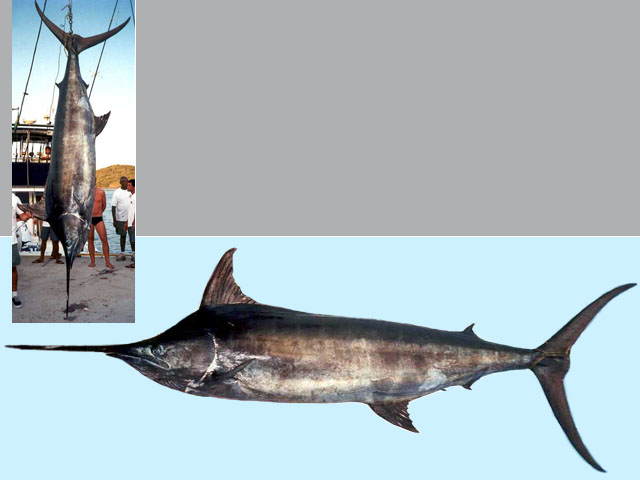| Istiophoridae (Billfishes) |
| 500 cm TL (male/unsexed); 500 cm TL (female); max.weight: 636 kg; max.weight: 820 kg |
|
pelagic-oceanic; marine; depth range 0 - 1000 m, oceanodromous |
| Atlantic Ocean: in tropical and temperate waters. We follow Nakamura 1985 (Ref. 43) in recognizing Makaira mazara and Makaira nigricans as two distinct species chiefly because of differences in the pattern of the lateral line system. Many scientists, however, do not recognize this character as specifically diagnostic and consider the latter species as a single pantropical species occurring in the Atlantic, Pacific and Indian oceans. Highly migratory species. |
|
Dorsal spines (total): 0-0; Dorsal soft rays (total): 45-50; Anal spines: 0-0; Anal soft rays: 19-23. Body blue-black above and silvery white below, with about 15 rows of pale cobalt-colored stripes; 1st dorsal fin plain blackish or dark blue, other fins brown black with a tinge of dark blue in some specimens; anal fin bases with a tinge of silvery white. Lateral line a network of interconnecting canals (Ref. 26938). |
| An oceanic species. Water color affects its occurrence, at least in the northern Gulf of Mexico, where the fish show preference for blue water. Rarely gathers in schools and usually found as scattered single individuals. Feeds mainly on fishes but also preys on octopods and squids. Marketed fresh or frozen (Ref. 43). Feeding takes place during daytime. Maturity reached at about 80 cm in males and 50 cm in females (Ref. 36731). Females grow larger (Ref. 4770). Recent study indicates maximum age close to 20 years using a series of deductions in the ¹⁴C dating method (Ref. 120707). |
|
Vulnerable (VU); Date assessed: 10 May 2021 (A2bd) Ref. (130435)
|
| harmless |
Source and more info: www.fishbase.org. For personal, classroom, and other internal use only. Not for publication.

